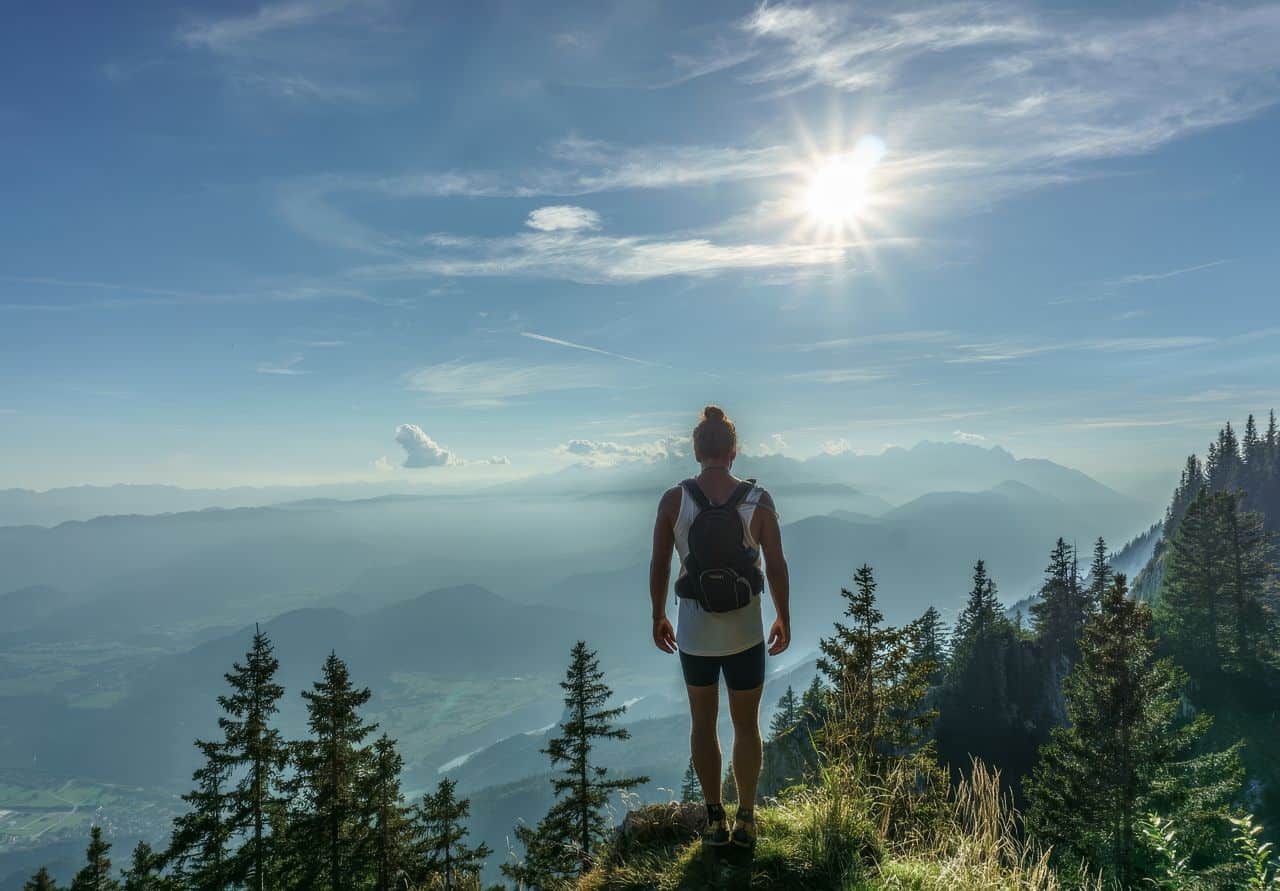Many people wonder, “How long is the Camino de Santiago route?” The answer depends on which path you choose. There are seven traditional routes ranging from 71 to 621 miles in length. 2 This blog will break down each route’s distance and provide all the essential details you need.
With over a decade of travel experience, I’ve walked several Camino paths myself—including the popular Camino Francés and the scenic Camino del Norte. 3 I can give you practical advice on what to expect.
Let’s get started! 1
Key Takeaways
The Camino de Santiago includes several routes, with distances ranging from 71 to 621 miles. Popular paths include the French Way (491 miles) and Vía de la Plata (621 miles).
Completion times vary by route: Camino Francés usually takes about 35 days for its 780-kilometer stretch, while shorter routes like Camino Inglés can be finished in around five to six days.
Different starting points influence journey length; for example, St Jean Pied de Port is a common start that covers approximately 780 kilometers to Santiago de Compostela.
Pilgrims typically walk an average of 20–25 kilometers per day. To maintain this pace and avoid injuries, planning rest days throughout the journey is crucial.
Seasonal weather impacts travel durations significantly—spring and autumn offer cooler temperatures ideal for hiking, while summer attracts higher foot traffic but also poses heat challenges.
Table of Contents
Exploring the Camino de Santiago
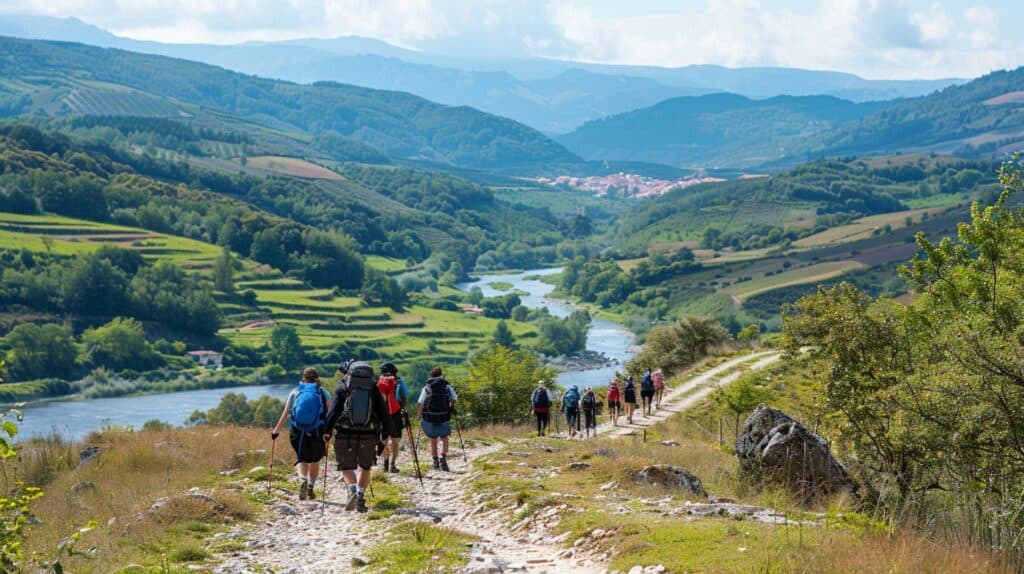
The Camino de Santiago is a famous pilgrimage route. One popular path is the French Way, or “Camino Francés”… starting in Saint-Jean-Pied-de-Port and ending at the Cathedral of Santiago.
Key Routes
Key routes on the Camino de Santiago include several paths with unique features. The Camino Francés, or the French Way, stretches 491 miles and is the most popular path. It begins at Saint-Jean-Pied-de-Port in France and ends at the Cathedral of Santiago de Compostela in Spain.
Hikers often require at least 28 days to finish this journey. 2
Another significant route is the Vía de la Plata—also known as The Silver Way—which starts in Seville. It covers a vast distance of 621 miles, demanding over 40 days to complete.
For those preferring shorter treks, there’s the Camino Inglés starting from Ferrol; it totals only 75 miles and can be finished in about six days. The coastal Camino del Norte spans 513 miles along Green Spain paralleling the Atlantic Ocean.
The easier Camino Portugués runs for 383 miles beginning from Lisbon and usually takes between 25-27 days to walk through its flat terrain. For adventure seekers, there’s also a challenging option—the rugged Camino Primitivo—covering mountainous terrain for around 200 miles through northern Asturias.
Each route offers distinct experiences for different preferences while leading you towards your destination: Santiago de Compostela. 1
Start and End Points
The pilgrimage route ends at the Cathedral of St. James in Santiago de Compostela, Spain. 1 The start points vary depending on which trail you choose. Most popular is the French Way, beginning at Saint-Jean-Pied-de-Port in France and stretching 270 miles to Spain. 3
Another key starting point is Pamplona, with a journey covering 244 miles to Logroño. Ponferrada marks another major spot—162 miles from Santiago de Compostela, with a tough climb up O Cebreiro at 2,300 feet.
For those extending their adventure westward to the sea, Camino Finisterre-Muxía stretches an extra 71 miles past Santiago de Compostela towards Cape Finisterre.
Next up: Detailed Distances of Camino de Santiago Routes…
Detailed Distances of Camino de Santiago Routes
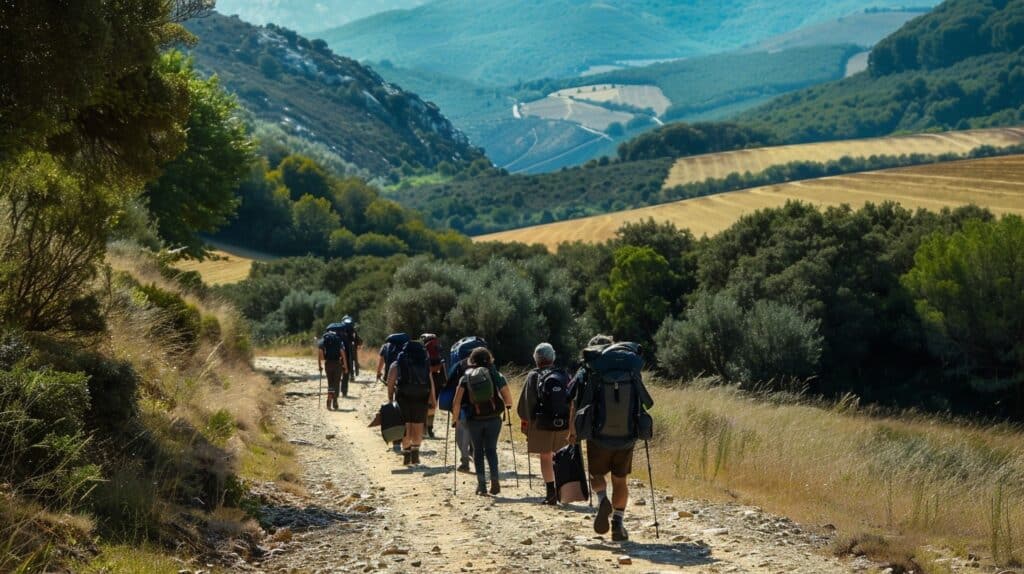
Some Camino routes are shorter, while others stretch hundreds of miles. Each path offers a unique experience and challenge… let’s dive in!
Distance of Camino Francés
The Camino Francés stretches approximately 780 kilometers from Saint Jean Pied de Port in France to Santiago de Compostela in Spain. 5 This popular pilgrimage, known as the “Way of Saint James,” takes about 35 days to complete if you walk an average of 25 kilometers per day. 4
Walking this route requires dedication and planning. Many pilgrims break it down into smaller sections, enjoying local restaurants and hostels along the way. The journey covers diverse terrain and elevation changes, making good hiking boots essential for a comfortable trek.
Distance of Camino del Norte
The Camino del Norte spans around 825 kilometers (512 miles). 6 Hikers start in San Sebastián and reach Santiago de Compostela. It takes about four to six weeks to complete the entire route.
Key sections include the Basque Country, Cantabria, Asturias, and Galicia.
Walking is a man’s best medicine. – Hippocrates
Expect varying terrains as you go through these regions. The last 100 km will take about five to six days. 7 Some trekkers finish faster due to fitness levels or fewer rest days.
Distance of Camino Portugués
The Camino Portugués route from Lisbon to Santiago de Compostela stretches 620 kilometers. It takes about 30 days to walk this distance. Starting in Porto shortens the journey to around 14 days.
The Central Camino covers a distance of 243 kilometers and usually takes around ten days. 9
The Coastal Camino is slightly longer at 265 kilometers, which walkers typically complete in eleven to twelve days. Together, the Coastal and Central routes made up 32% of pilgrims in 2023. 8 Both offer unique experiences through various terrains and historic sites on your pilgrimage route to Santiago de Compostela.
Distance of Camino Primitivo
The Camino Primitivo spans 321 kilometers. This route starts in Oviedo and ends at Santiago de Compostela. It is known as the toughest path due to steep ascents and descents. 10Pilgrims complete it in 12-14 days, averaging about 23 kilometers a day. 11 The challenging terrain demands good fitness levels, making it ideal for those seeking more adventure on their pilgrimage routes to Santiago de Compostela.
Distance of Camino Inglés
After covering Camino Primitivo, let’s delve into the details of Camino Inglés. This route is 116 km long and takes around 4 to 6 days to complete. Starting in Ferrol, it goes through beautiful landscapes until it reaches Santiago de Compostela’s Cathedral. 12
Many pilgrims appreciate that this path includes a church for the final stamp near Santiago. It offers a unique pilgrimage experience with a shorter travel time compared to other routes like the Vía de la Plata or Camino Francés. 13
Distance of Vía de la Plata
The Vía de la Plata stretches an impressive 621 miles. You start in Seville and walk through varied trails. This route is the longest, boasting over 1000 km. 15 The journey can take around six weeks with 34 stages. 14 Unlike the Camino Francés, you will find fewer uneven terrains here.
The Vía de la Plata offers a unique experience for hikers and pilgrims alike. Each stage gives you something different to see and do. This route challenges your endurance but rewards your spirit.
A thousand-mile journey begins with a single step.
Distance of Camino Finisterre-Muxía
Camino Finisterre-Muxía stretches 71 miles from Santiago de Compostela to the Atlantic coast. The official marker shows 89.586 kilometers (55.67 miles) to Finisterre. 17 The route continues for another 90 kilometers, taking about five days to complete. 16
This track ranks as a moderate difficulty path and is trekked year-round. Men hiking this route should expect varied terrain but no extreme challenges—ideal for both seasoned hikers and those with basic fitness levels looking for an adventure along “el Camino de Santiago.
Factors Influencing Travel Duration
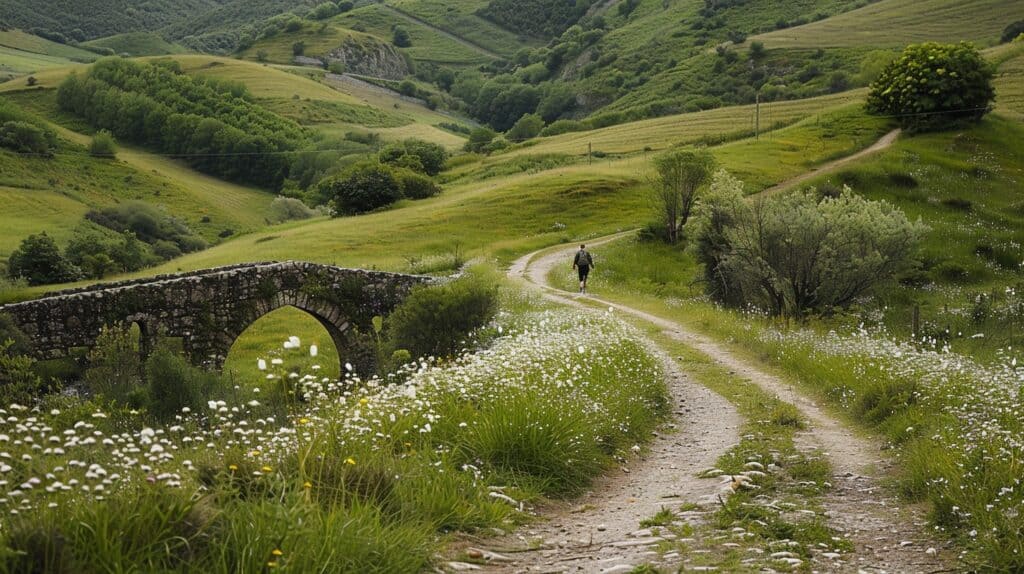
The landscape and how steep it is can slow you down, so can weather changes and how fast you walk. Find out more about these points….
Terrain and Elevation Challenges
The Camino Primitivo is the toughest route. It has many steep climbs and drops. The final stretch from Ponferrada to Santiago de Compostela includes a 2,300-foot climb to O Cebreiro. 18
The Vía de la Plata offers varied trails, but fewer uneven terrains compared to the Camino Francés. You will see verdant hillsides, eucalyptus forests, rolling farmlands, and expansive plains on this route. 1
“Every step taken adds another story worth telling.”
Average Walking Speed
Pilgrims usually cover 20–25 kilometers each day on the Camino de Santiago. 20 This average walking speed allows finishing the last 100 km in about five or six days. 19 Most travelers find this pace manageable, giving enough time to enjoy the sites and services along the way.
The terrain can affect speed; flat paths are easier than steep climbs. The weather also plays a role—rain can slow you down, while clear skies make for faster trekking. Adapting your daily plan helps maintain a steady pace and fully enjoy your trip without rushing through “the way of Saint James.
Seasonal Weather Variations
Camino de Santiago’s weather varies by season. April, May, June, September, and October offer cooler temperatures—ideal for hiking the trails. July and August see high foot traffic as many pilgrims take their vacations then.
Winter brings fewer crowds and lower hotel prices but also fewer open albergues.
Weather conditions impact travel duration significantly. Rain in autumn or heatwaves in summer can slow your pace on the pilgrimage to Santiago de Compostela. Proper planning helps navigate these seasonal challenges effectively—ensuring a smoother journey along routes like the Camino Francés or Camino Portugués. 21 20
Typical Completion Times for Camino Routes
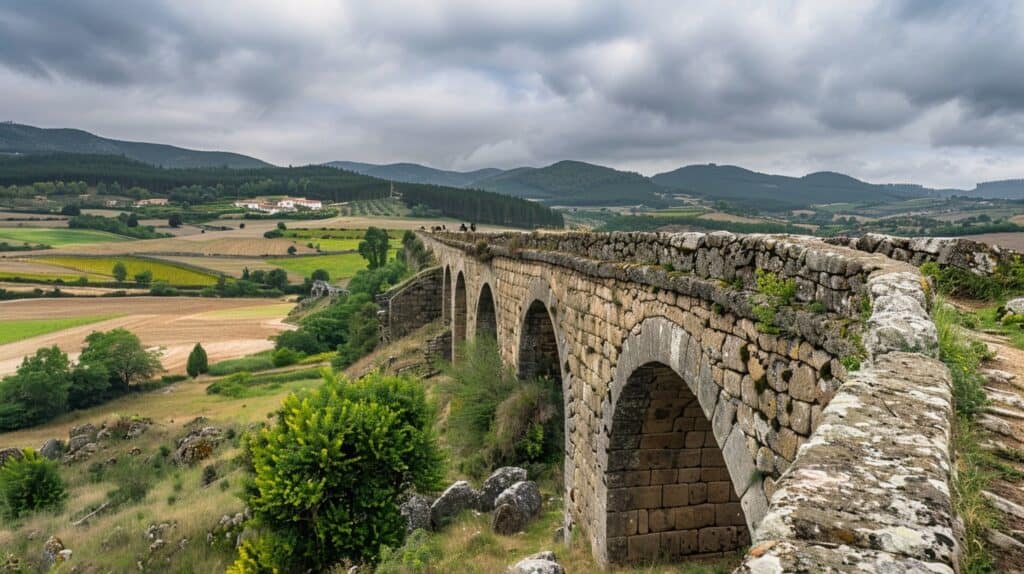
Most people take about 30 to 35 days to finish the Camino Francés. Other routes can be shorter, taking between one and two weeks… it depends on the path chosen.
Completion Time for Camino Francés
Walking the full Camino Francés, from St Jean Pied de Port to Santiago de Compostela, takes about 35 days. 4 You will need to walk an average of 25 kilometers per day. The route covers a total distance of 780 kilometers.
This journey allows for one rest day each week, giving time to recover and enjoy the surroundings.
Factors such as physical fitness and weather can impact your travel time on this pilgrimage route—the Way of St. James is not easy. Weather variations might cause delays or faster paces depending on conditions.
Each pilgrim’s experience differs based on these factors, but many find completion around the 35-day mark reasonable if they maintain a steady pace and adequate rest periods. 22
Completion Time for Camino del Norte
The Camino del Norte is about 825 kilometers (512 miles) long. 6 It takes roughly four to six weeks to finish the route. Starting from San Sebastián, the journey typically lasts around 37 days.
Factors like walking pace and physical fitness affect travel time. 4 Pilgrims may need extra days for rest or exploring sights along the way of St. James.
Completion Time for Camino Portugués
The Camino Portugués route from Lisbon to Santiago de Compostela stretches 620 km. 9 The Central Camino from Porto covers 243 km and takes around 10 days to complete. 9 The Coastal Camino from Porto, a bit longer at 265 km, requires about 11–12 days. 23
Pilgrims need to consider their pace. Faster walkers can finish quicker; slower ones may take extra time. Terrain and weather affect the journey too… steep hills or rain can add days.
Most travelers find these times reasonable, with daily walks of around 20-25 km per day.
Completion Time for Camino Inglés
Camino Inglés is about 116 km long. 4 You can walk it in five to six days. On average, people cover 20-25 kilometers each day. Starting from Ferrol, you’ll need about one week to complete the journey. 24 Factors like physical fitness and weather can affect your pace.
Preparing for the Camino Journey
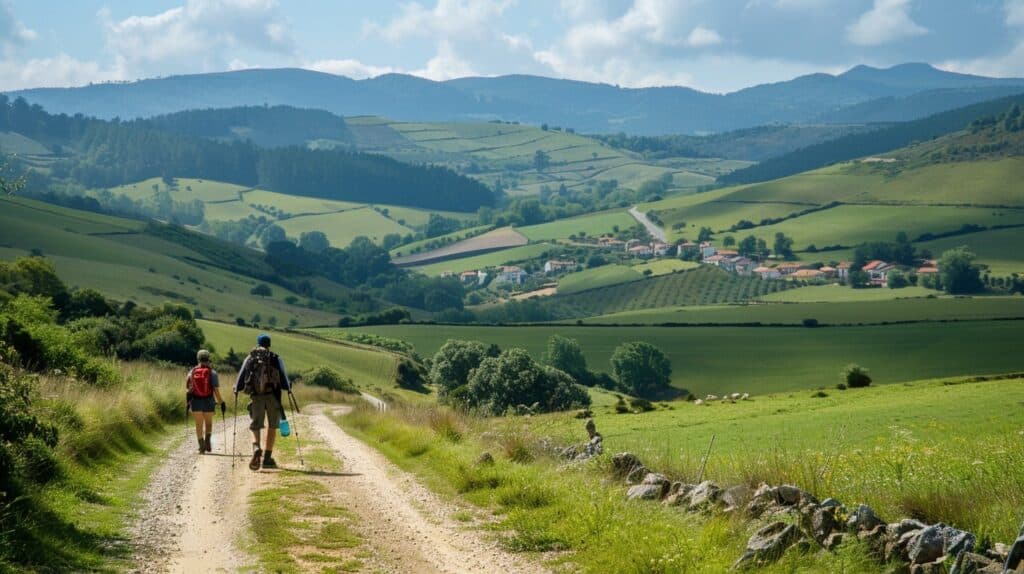
Pack light, wear comfortable shoes, plan your route carefully… and get ready for an adventure!
Developing a Daily Walking Plan
A daily walking plan is crucial for anyone tackling the Camino de Santiago. Start training by walking 5 km (3.1 mi) a day, three times a week. This prepares both body and mind for the long journey ahead.
Stick to this routine faithfully… it strengthens your endurance.
Planning rest days helps manage fatigue and boosts morale along the route. Schedule these breaks based on personal fitness levels and terrain challenges like steep inclines or rugged paths.
Boost recovery with nutritious meals—some favorite stops include Sarria or Hostal de los Reyes Católicos for traditional set menus.
Selecting Routes and Booking Accommodations
Choose your Camino route based on what you want to experience. The Camino Francés is the most popular, stretching around 780 kilometers from Saint-Jean-Pied-de-Port to Santiago de Compostela. 26 If coastal views are your thing, try the Camino del Norte, which covers about 820 kilometers along Spain’s northern coast. For a shorter trip, consider the Camino Inglés from A Coruña—only about 120 kilometers.
Book accommodations ahead of time for peace of mind. Municipal albergues offer budget-friendly options with basic facilities. Private albergues provide more comfort but might cost more.
Donation-based albergues are available too; however, spots can fill up quickly in peak seasons like during St James’ Day or Holy Years. 1 For extra comfort, opt for hotels or guesthouses—they ensure a restful night after long hikes on these UNESCO World Heritage Sites routes.
Plan rest days and enjoy local events like San Fermín Festival if timing aligns with your journey dates… This mix ensures you won’t just travel anonymously, but have an enriching camino adventure!
Scheduling Rest Days
Rest days are important on the Camino de Santiago. Walking long distances every day can tire you out and cause injuries. Plan to rest every few days, especially if you’re new to long-distance walking or have any injuries.
These breaks let your body heal and help prevent sore muscles. 27
Use rest days to explore towns along the route. Enjoy local culture, try regional foods, and visit historic sites like cathedrals and museums. Rest also gives time for laundry, buying supplies, or simply relaxing in a cozy café with fellow pilgrims on routes like Camino Francés or Vía de la Plata. 28
Strategies for Effective Time Management on the Camino
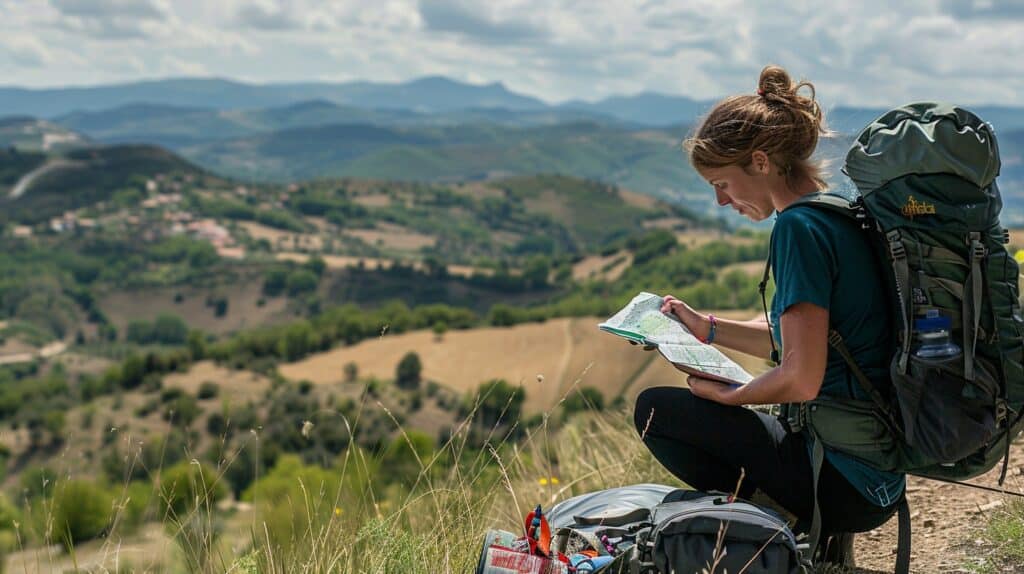
Know how far you plan to walk each day. Adjust your pace to match your fitness level and get pilgrim passport stamps on time.
Handling Daily Walking Distances
Walking the Camino de Santiago means covering 20-25 km daily. 29 This can be tough on your body. To handle this better, start slow and build up your stamina. Use a daypack for essentials like water, snacks, and a rain jacket.
Pay attention to your body’s signals. Rest when needed and take short breaks every few hours. These pauses help prevent blisters and fatigue—carry bandages for quick fixes, too! 4
Adapting to Personal Fitness Levels
Many find long walks challenging, so adjusting to personal fitness levels becomes crucial. Start by walking 5 km (3.1 mi) a day, thrice weekly. 25 This prepares your body for the Camino de Santiago.
Training also helps you understand your pace and limits.
Families and couples can strengthen their bonds during this journey. Walking together improves trust, communication, and mutual understanding—making the pilgrimage meaningful on multiple levels. 1 Tailor your daily distances based on how comfortable you feel after each walk to prevent exhaustion or injury.
Timing for Pilgrim Passport Stamps
Pilgrim passport stamps are vital on the Camino de Santiago. To receive your Compostela, you must collect at least two stamps per day in the last 100 km before reaching Santiago. 30 Stamps can be obtained at churches, hostels, and cafés along the way of St.
James.
Most establishments available for stamps operate during regular business hours — typically from 8 AM to 8 PM. It’s wise to plan your stops accordingly. Popular routes like the Camino Francés and Portuguese Way offer numerous places to get these essential stamps each day. 4
People also Ask
How long is the Camino de Santiago route?
The main route, called the French Way, is about 500 miles (800 kilometers) long.
What are some other routes of Santiago de Compostela?
Other routes include the Portuguese Way, Via Turonensis, and Camino Ingles.
When can pilgrims get their stamps for the Pilgrim Passport?
Pilgrims can collect stamps at churches, hostels, and cafés along the way during their journey to Santiago de Compostela.
Are there shorter options for walking the Camino?
Yes! The Portuguese Way is around 380 miles (611 kilometers), while others like Camino Ingles are even shorter at about 70 miles (113 kilometers).
Is there a special time to walk the pilgrimage to Santiago?
Many choose St James’s Day on July 25th or during a Jubilee Year when extra events take place along Christian pilgrimage paths.
Can you give examples of popular stops along these routes?
Examples include Finisterrae on The Milky Way path and Domingo de la Calzada on Via Francigena.
References
- ^ https://www.ncbi.nlm.nih.gov/pmc/articles/PMC10150338/
- ^ https://followthecamino.com/en/camino-de-santiago-routes/
- ^ https://caminoways.com/camino-de-santiago
- ^ https://www.caminosantiagocompostela.com/how-long-does-take-walk-camino-all-routes/ (2023-07-16)
- ^ https://caminoways.com/camino-de-santiago-routes
- ^ https://followtheyellowshell.com/how-long-is-the-camino-del-norte/
- ^ https://caminoways.com/camino-del-norte
- ^ https://stingynomads.com/camino-de-santiago-routes/
- ^ https://www.cicerone.co.uk/camino-portugues-should-you-walk-the-central-or-coastal-camino-from-porto
- ^ https://stingynomads.com/camino-primitivo-stages/ (2024-03-15)
- ^ https://whatsdavedoing.com/camino-primitivo-guide/
- ^ https://stingynomads.com/english-way-camino-de-santiago-stages/
- ^ https://followtheyellowshell.com/camino-ingles/
- ^ https://santiago-compostela.net/via-de-la-plata/
- ^ https://stingynomads.com/via-de-la-plata-camino-de-santiago/
- ^ https://caminoways.com/camino-finisterre/camino-finisterre-from-santiago-to-muxia
- ^ https://www.packing-up-the-pieces.com/camino-finisterre-muxia-guide/ (2022-10-26)
- ^ https://www.researchgate.net/publication/271622200_Tourists_and_pilgrims_on_their_way_to_Santiago_Motives_Caminos_and_final_destinations
- ^ https://galiwonders.com/en/blog/how-long-is-the-camino-de-santiago/
- ^ https://thenwewalked.com/walking-the-camino-de-santiago/ (2024-02-11)
- ^ https://www.researchgate.net/publication/329374702_The_Camino_is_Alive_Minor_Logics_and_Commodification_in_the_Camino_de_Santiago
- ^ https://caminoways.com/how-many-days-does-it-take-to-walk-the-camino-de-santiago (2023-11-27)
- ^ https://stingynomads.com/camino-portugues-stages/
- ^ https://caminoways.com/walking-the-camino-de-santiago (2023-11-28)
- ^ https://stingynomads.com/camino-de-santiago-training/
- ^ https://americanpilgrims.org/prepare-for-camino/
- ^ https://followthecamino.com/en/blog/rest-days-on-the-camino-de-santiago/ (2022-01-12)
- ^ https://www.caminodesantiago.me/community/threads/how-many-days-including-rest-days-do-i-need-to-do-the-camino-frances-to-finisterre.42345/
- ^ https://stingynomads.com/camino-de-santiago-walking-guide/ (2024-03-20)
- ^ https://www.caminodesantiago.me/community/threads/pilgrim-passport-number-of-stamps.62753/ (2019-06-13)
